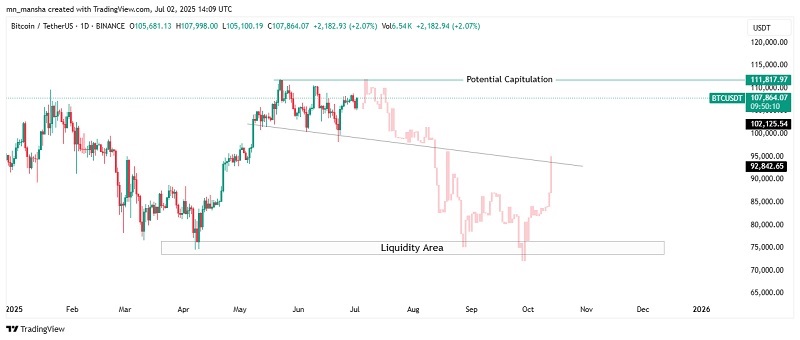Il Capo of Crypto is a veteran swing trader and market analyst active since February 2017, with over 968,600 followers on X and 128,554 followers on Telegram. He built his reputation by delivering timely market calls that often aligned with subsequent price moves, early indicators of Bitcoin pullbacks, and precise entries in high-beta altcoins have cemented his credibility.
His framework blends classic chart-pattern analysis (support/resistance flips, trend-line breaks) with on-chain metrics (exchange flows, whale activity), giving traders a disciplined lens to interpret crypto’s relentless volatility. Is Bitcoin going to crash? Il capo’s recent post sparks a debate and a bit of FUD among the Bitcoiners.
Il Capo of Crypto: Bearish Bitcoin Prediction
Just days earlier, on June 27, 2025, he reverted to a bearish stance on altcoins. In that post, he described recent recoveries as “dead cat bounces” and argued that many tokens have retraced into former ranges, setting the stage for further declines. Solana (SOL), he noted, is down about 20 % from a key resistance zone and faces targets near $60–$80.
Beyond SOL, he flagged Ethereum’s precarious positioning: hovering at a major resistance cluster, ETH risked a 10 % pullback unless it reclaimed that zone decisively. He also reminded followers that since late May, he’s been adding to short positions across high-beta altcoins—BNB, TRX, MATIC, and AAVE—all of which could see 50 %–80 % drops if Bitcoin’s descent accelerates.
On June 28, 2025, Il Capo laid out a detailed chart-based case for Solana’s potential 58 % fall into the $60–$80 range, highlighting a critical support/resistance flip at that band and warning that weakness in SOL often presages broader market stress.
On June 30, 2025, Il Capo tweeted that the recent Bitcoin bounce failed to mark true capitulation. He warned that BTC could slip below $100,000, test $92,000–$93,000, and ultimately decline to $60,000–$70,000. These are the levels he views as potential cycle lows.
Is Bitcoin Going to Crash?
The Bitcoin price prediction by Il Capo of Crypto is mainly based on technical indicators. If we look at the indicators, the bearish prediction of Bitcoin going to crash makes sense.
The fear of a sudden Bitcoin collapse often feels tangible, especially when charts flash red and commentators point to lower “liquidity areas.” First, Bitcoin sits comfortably above its 20-, 50-, even 100-day EMAs (106 k, 104 k, 100 k respectively), all pointing upward in unison, so far so good. That ribbon of moving averages acts like local support here.
The so-called “liquidity zone” around $75 k–$80 k lies far below current levels. Yes, price could drift toward that band if panic grips traders, but such a move would require a decisive break below the 200-day EMA (~94k). History shows Bitcoin rarely dives straight through multiple long-term averages without pausing or rebounding first.

Average true range (ATR) sits near $2.6k, meaning daily swings of $2 000–$3 000 are normal, not catastrophic. A $10 000 drop overnight would be five ATR moves, an extreme outlier that demands a real-world shock: major exchange outage, regulatory U-turn, or network failure. None of those are imminent, as far as the technical indicators are concerned.
In short, a “crash” feels unlikely in the absence of a clear catalyst. Instead, a slow move to the downside with small reversals is possible. Pullbacks toward the EMA ribbon or the descending resistance line (currently near $92 k) would offer healthy resets. Traders brace for a 20% retracement and use it to lighten leverage or add at support. So, we are expecting an eventual move rather than an apocalyptic crash of Bitcoin.
Nonetheless, Il Capo’s message is not mere pessimism but a call to action: protect capital, tighten stops, and focus on key levels. By tying his targets to clearly defined chart points and on-chain signals, he offers a roadmap for trading through the next leg of crypto volatility. Whether markets rally or unwind further, his data-driven approach serves as both a warning siren and a guidepost for disciplined risk management.



